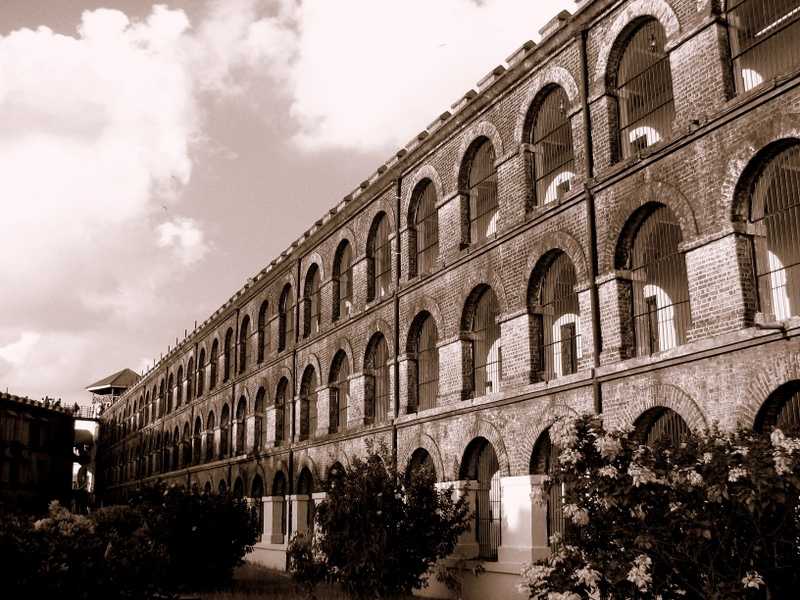Indian Jails You Can Go To Without Getting Convicted
1. Cellular Jail, Andaman & Nicobar Islands
Located on the east coast of South Andaman Islands, this is one such place every one of us must have heard about. The name “Cellular Jail” itself proclaims the state of complete social exclusion, miles away from the Indian mainland. The strugglers of the Indian independence movement were brought here and were exiled for life.

Cellular Jail (Source)
The jail has also witnessed the activities from the World War II, when the Japanese invaded the islands in 1942 and made it the home for British Prisoners, until it was again taken over by the British in 1945 soon as they won the war in 1945. Presently people can look into the dark past of the jail, by a sound and light show, which narrates the saga of the Indian freedom struggle.
The Cellular Jail is open for tourists everyday except for Mondays and Public Holidays. The visiting hours are between 9:00 am and 5:00 pm. The timings for the Light and Sound show is: 5:30 pm – 6:30 pm (Hindi) and 6:45 pm – 7:45 pm.
2. Tihar Jail, Delhi

Tihar Jail (Source)
Located in the capital of the country, Tihar Jail is known for having the largest complex of any prison in South Asia. Established as the maximum security prison by the State of Punjab in 1957, it is one of the most famous prisons in India. The prison is also famous for the rehabilitation of the inmates as on completing their sentence the prisoners can appear for the placements as well as higher studies. This subject came to notice when one inmates successfully made it into the Indian Administrative Services.
Some parts of the Jail, including the canteen is accessible to tourists.
3. Hijli Jail, West Bengal
Established as a Hijli Detention camp in 1930, the Hijli Jail played a notable role in the Indian movement for independence. It is infamous for the “Hijli Firing” incident of 1931, which is the only known incident where the police have opened fire on the unarmed prisoners.

Hijli Jail (Source)
Soon after the independence in 1951, the detention camp led to the birth of the first IIT of the country. Currently it is located within the campus of IIT Kharagpur and the former detention camp has been converted as the Nehru Museum of Science and Technology. Tourists can visit IIT Kharagpur campus and have a detailed tour of the Museum.
4. Cells of Viper Islands, Andaman & Nicobar Islands
The ‘Gallows of Viper Islands’ are not as famous as the Cellular Jail in Port Blair, but they played a similar role in during the Indian freedom struggle. These secluded jails were constructed years before the Cellular Jail and were used to torture any Indian who would dare to speak up against the British Rule.

Gallows of Viper (Source)
Today, the remnants of the gallows against the picturesque backdrop definitely gives a bittersweet feeling to the tourists.
Other interesting Prisons in India (Not open for tourists)
5. Yerwada Jail, Maharashtra

Yerwada Jail (Source)
This maximum security jail is notably the largest jail in Maharashtra, and one of the largest on South Asia. Built by the Britishers in 1871, Yerwada is one of the more highlighted prisons because Mahatama Gandhi had been imprisoned here during the independence movement in the 30s and 40s. Apart from having a textile mill and a separate radio station by, for, and of the inmates, there is an Open Jail of Yerwada where prisoners live under basic security and grown fruits and vegetables. Presently, Gandhian principles are taught to prisoners who wish to learn them. This Jail is, however, not open for tourists.
6. Madras Central Jail, Chennai
The Madras Central Jail was, arguably, the oldest jail of India before it was demolished in late 2009. It is believed to have been built to house the prisoners who were to be transferred to ‘Kaala Pani’ at Cellular Jail, Port Blair. Famous freedom fighters like Netaji Subhas Chandra Bose and Veer Savarkar had served time in this penitentiary.

Madras Central Jail (Source)
Presently, a part of the prison premises has been reconstructed and is being used as a new campus for buildings of Madras Medical College.
7. Naini Central Jail, Uttar Pradesh

Naini Central Jail (Source)
Yet another correctional facility built during the British Raj, the Naini Central Prison is prominent because the first Prime Minister of India, Jawaharlal Nehru, was once an inmate there. This prison played a big role in the freedom struggle of India. Later, even Indira Gandhi was sent to Naini. Recently, wooden furniture made by the inmates here have been used in Allahabad High Court and district courts. It is not open for tourists.
8. Rajahmundry Central Jail, Andhra Pradesh

Rajahmundry Central Jail (Source)
This prison was established by the Dutch in 1602 as a fort, but then was transformed into the prison in 1864. Spread across a massive area of 196 acres, it is known for struggle of the Indian people under the British Raj, which is then bounded in the walls of the cells. It unique for the literacy rate of the prisoners. There are several courses run inside the premises for the development of the prisoners. Besides this, the inmates also involve in various productive activities- A place which once was known for seizing human rights, is a nucleus for recreation.
No comments:
Post a Comment